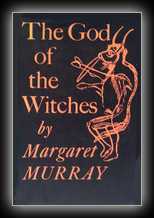
God of the Witches
by Margaret Alice Murray, D.Lit.
1933
This book is intended for the general reader as well as for the student of anthropology. In this volume I have followed one line only of anthropological enquiry, the survival of an indigenous European cult and the interaction between it and the exotic religion which finally overwhelmed it. I have traced the worship of the Horned God onwards through the centuries from the Paleolithic prototypes, and I have shown that the survival of the cult was due to the survival of the races who adored that god, for this belief could not have held its own against the invasions of other peoples and religions unless a stratum of the population were strong enough to keep it alive... Dr Margaret Alice Murray
The Horned God is one of the two primary deities found in some neopagan religions. He is often given various names and epithets, and represents the male part of the religion's duotheistic theological system, the other part being the female Triple Goddess. In common Wiccan belief, he is associated with nature, wilderness, sexuality, hunting and the life cycle. :32-34 Whilst depictions of the deity vary, he is always shown with either horns or antlers upon his head, often depicted as being theriocephalic, in this way emphasizing "the union of the divine and the animal", the latter of which includes humanity.:11 The term Horned God itself predates Wicca, and is an early 20th century syncretic term for a horned or antlered anthropomorphic god with pseudohistorical origins who, according to Margaret Murray's 1921 The Witch-Cult in Western Europe, was the deity worshipped by a pan-European witchcraft-based cult, and was demonized into the form of the Devil by the Mediaeval Church. The Horned God has been explored within several psychological theories, and has become a recurrent theme in fantasy literature
